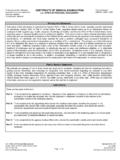Transcription of Silicon Wafer Processing
1 Silicon Wafer Processing Dr. Seth P. Bates Applied Materials Summer, 2000 Objective To provide an overview for manufacturing systems students of the steps and processes required to make integrated circuits from blank Silicon wafers. Goals The Transfer Plan provides a curriculum covering the process of manufacturing integrated circuits from the Silicon Wafer blanks, using the equipment manufactured by Applied Materials, Lam Research, and others of its competitors. The curriculum will be modular, with each module covering a process in sequence. This curriculum will be developed for internet access. Outline Introduction Preparation of the Silicon Wafer Media Silicon Wafer Processing Steps Seth Bates SJSU / Applied Materials / IISME-ETP page 1 Silicon Wafer Processing Outline of Contents Introduction .. 2 Preparation of the Silicon Wafer 3 Crystal Growth and Wafer Slicing Process Thickness Sorting Lapping & Etching Processes Thickness Sorting and Flatness Checking Polishing Process Final Dimensional and Electrical Properties Qualification Silicon Wafer Processing Steps.
2 8 Fabrication Diffusion Coat-Bake Align Develop Dry etch Wet etch & clean Photolithography Implant / Masking Steps Die Attach / Wire Bond Encapsulation Lead Finish / Trim and Form Final Testing / Shipping Seth Bates SJSU / Applied Materials / IISME-ETP page 2 Introduction The Processing of Silicon wafers to produce integrated circuits involves a good deal of chemistry and physics. In order to alter the surface conditions and properties, it is necessary to use both inert and toxic chemicals, specific and unusual conditions, and to manipulate those conditions with both plasma-state elements and with RF (Radio Frequency) energies. Starting with thin, round wafers of Silicon crystal, in diameters of 150, 200, and 300mm, the processes described here build up a succession of layers of materials and geometries to produce thousands of electronic devices at tiny sizes, which together function as integrated circuits (ICs). The devices which now occupy the surface of a one-inch square IC would have occupied the better part of a medium-sized room 20 years ago, when all these devices (transistors, resistors, capacitors, and so on) were only available as discreet units.
3 The conditions under which these processes can work to successfully transform the Silicon into ICs require an absolute absence of contaminants. Thus, the process chambers normally operate under vacuum, with elemental, molecular, and other particulate contaminants rigorously controlled. In order to understand these processes, then, we will begin the study of semiconductor Processing with an overview of vacuum systems and theory, of gas systems and theory, as applied specifically to these tools, and of clean room processes and procedures The semiconductor industry reflects and serves an extraordinary revolution in both materials science and in data Processing and storage. As recently as 1980, most individuals had no idea that computers would ever impact their personal lives. Today, many families own one or two computers, and use many other computers and dedicated processor systems in their appliances and automobiles. The intrusion of electronics and computer technology into our lives and the devices we use daily is growing at an exponential rate, and Moore s Law still applied in the computer world.
4 This is one of the few markets in which, as time passes, the power and capacity of the products grows steadily, while the cost of that power and capacity drops. Today, only twenty years later, we are continually pushing the envelope of capabilities of the data Processing and storage systems that are now in the mainstream. Ingenuity and creativity, along with great strides in quality control, process control, and worker productivity, are leading daily to new ideas about how to further reduce device size and data density. On the horizon are visions of biochemically-based devices which will be far smaller, work faster, and generate less heat than current devices. It is worth spending some time imagining where this evolving technology will take us, and the society we live in. Seth Bates SJSU / Applied Materials / IISME-ETP page 3 Preparation of the Silicon Wafer Media From: Wafer products are measured at various stages of the process to identify defects inducted by the manufacturing process.
5 This is done to eliminate unsatisfactory Wafer materials from the process stream and to sort the wafers into batches of uniform thickness and at a final inspection stage. These wafers will become the basic raw material for new integrated circuits. The following is a summary of the steps in a typical Wafer manufacturing process. Crystal Growth and Wafer Slicing Process The first step in the Wafer manufacturing process is the formation of a large, perfect Silicon crystal. The crystal is grown from a seed crystal that is a perfect crystal. The Silicon is supplied in granular powder form, then melted in a crucible. The seed is immersed carefully into the crucible of molten Silicon , then slowly withdrawn. Step 1: Obtaining the Sand The sand used to grow the wafers has to be a very clean and good form of Silicon . For this reason not just any sand scraped off the beach will do. Most of the sand used for these processes is shipped from the beaches of Australia.
6 Step 2: Preparing the Molten Silicon Bath The sand (SiO2)is taken and put into a crucible and is heated to about 1600 degrees C just above its melting point. The molten sand will become the source of the Silicon that will be the Wafer . Step 3: Making the Ingot A pure Silicon seed crystal is now placed into the molten sand bath. This crystal will be pulled out slowly as it is rotated. The dominant technique is known as the Czochralski (cz) method. The result is a pure Silicon cylinder that is called an ingot. As description or a variant on the Czochralski method is available at The Czochralski method Silicon Thermal Properties Thermal Conductivity (solid) W/cm-K Thermal Conductivity (liquid) W/cm-K Specific Heat J/g-K Thermal Diffusivity .9 cm**2/s Melting Point 1683 K Boiling Point 2628 K Critical Temperature 5159 K Density (solid) g/cm**3 Density (liquid) g/cm**3 Vapor pressure at 1050C 1e-7 Torr at 1250C 1e-5 Torr Molar heat capacity J/mol-K Seth Bates SJSU / Applied Materials / IISME-ETP page 4 Examples of some completed ingots An epitaxial reactor.
7 Growth of Epitaxial Silicon This step is done to provide a good clean surface for later Processing . If a layer of Silicon is grown onto the top of the Wafer using chemical methods then that layer is of a much better quality then the slightly damaged or unclean layer of Silicon in the Wafer . The epitaxial layer is where the actual Processing will be done. The diameter of the Silicon ingot is determined by the temperature variables as well as the rate at which the ingot is withdrawn. When the ingot is the correct length, it is removed, then ground to a uniform external surface and diameter. Each of the wafers is given either a notch or a flat edge that will be used later in orienting the Wafer into the exact position for later procedures. In these two figures you can see a notch (above) and flats. Flats in this image are exaggerated for clarity. Step 4: Preparing the Wafers After the ingot is ground into the correct diameter for the wafers, the Silicon ingot is sliced into very thin wafers.
8 This is usually done with a diamond saw. A diamond saw for cutting wafers Each of these wafers will then go through polishing until they are very smooth and just the right thickness (see Polishing Process, below). Thickness Sorting Seth Bates SJSU / Applied Materials / IISME-ETP page 5 Following slicing, Silicon wafers are often sorted on an automated basis into batches of uniform thickness to increase productivity in the next process step, lapping. During thickness sorting, the Wafer manufacturer can also identify defect trends resulting from the slicing process. Lapping & Etching Processes Lapping removes the surface Silicon which has been cracked or otherwise damaged by the slicing process, and assures a flat surface. Wafers are then etched in a chemically active reagent to remove any crystal damage remaining from the previous process step. Thickness Sorting and Flatness Checking Following lapping or etching, Silicon wafers are measured for flatness to identify and control defect trends resulting from the lapping and etching processes.
9 Wafers are also often sorted on an automated basis according to thickness in order to increase productivity in the next process step, polishing. Polishing Process Polishing is a chemical/mechanical process that smoothes the uneven surface left by the lapping and etching processes and makes the Wafer flat and smooth enough to support optical photolithography. A Wafer polishing machine Wafers in storage trays Final Dimensional and Electrical Properties Qualification The wafers undergo a final test, performed in order to demonstrate conformance with customer specification for flatness, thickness, resistivity and type. Process induced defect and defect trend information is used by the Wafer manufacturer for yield and process management of the immediately preceding steps. Information regarding surface defects, such as scratches and particles, and defect trend information are used by the Wafer manufacturer for yield and process improvement. Seth Bates SJSU / Applied Materials / IISME-ETP page 6 Seth Bates SJSU / Applied Materials / IISME-ETP page 7 Silicon Wafer Processing Steps Semiconductor manufacturing from Today, most integrated circuits (ICs) are made of Silicon .
10 Turning Silicon into memory chips is an exacting, meticulous procedure involving engineers, metallurgists, chemists and physicists. The first step from Silicon to circuit is the creation of a pure, single-crystal cylinder or ingot of Silicon six to eight inches in diameter. These cylinders are sliced into thin, highly polished wafers less than one-fortieth of an inch thick. Micron uses six- and eight-inch wafers. The circuit elements (transistors, resistors, and capacitors) are built in layers on the Silicon Wafer . Hundreds of memory chips are etched onto each Wafer . Pure single-crystal cylinders of Silicon are sliced into thin, highly polished wafers less than one-fortieth of an inch thick. Hundreds of memory chips are etched onto each Wafer , while for processor chips, perhaps only ten to 50 devices will fit on one Wafer . Most chip designs are developed with the help of computer systems or computer-aided design (CAD) systems. Circuits are developed, tested by simulation, and perfected on computer systems before they are actually built.




